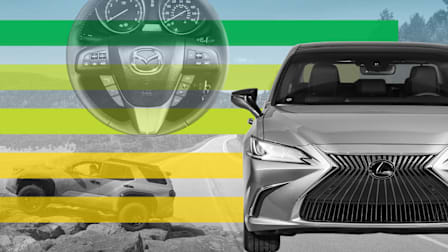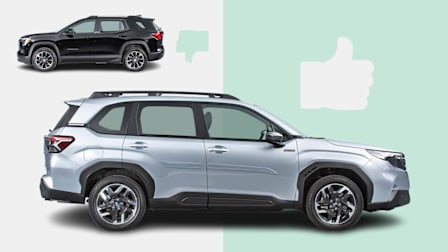Leasing vs. Buying a New Car
Leasing generally keeps monthly payments lower, but you don't build equity. Is leasing or buying a car better for you?

New car prices remain high, which complicates the choice between buying and leasing a car.
On the one hand, buying involves higher monthly costs. But after you pay off the loan you own an asset—your vehicle. On the other hand, a lease has lower monthly payments and lets you drive a vehicle that may be more expensive than you could afford to buy. However, you get into a cycle in which you never stop paying for a vehicle.
- Leasing: Upsides Downsides the EV Exception
- Loans vs. Leases: Similarities Differences
- Don't Forget to Negotiate
The Upside of Leasing
Leases usually have lower monthly payments because you’re not paying back the full principal. Instead, you’re just borrowing and repaying the difference between the car’s value when new and the car’s residual—its expected value when the lease ends—plus finance charges. The major advantages of leasing include:
- You drive the car during its most trouble-free years.
- You’re always driving a late-model vehicle that’s usually covered by the manufacturer’s new-car warranty.
- The lease may even include free oil changes and other scheduled maintenance.
- You can drive a higher-priced, better-equipped vehicle than you might otherwise be able to afford.
- Your vehicle will have the latest active safety features.
- You don’t have to worry about fluctuations in the car’s trade-in value or go through the hassle of selling it when it’s time to move on.
- There could be significant tax advantages for business owners.
- When the lease is over you just drop off the car at the dealer.
The Disadvantages of Leasing
As attractive as a lease may appear, there are a number of disadvantages:
- In the end, leasing usually costs you more than an equivalent loan because you’re paying for the car during the time when it is most rapidly depreciating.
- If you lease one car after another, monthly payments go on forever. By contrast, the longer you keep a vehicle after the loan is paid off, the more value you get out of it. Over the long term, the cheapest way to drive is to buy a car and keep it until it’s uneconomical to repair.
- Lease contracts specify a limited number of miles. If you go over that limit, you’ll have to pay an excess mileage penalty. That can range from 10 cents to as much as 50 cents for every additional mile. So be sure to calculate how much you plan to drive. You don’t get credit for unused miles.
- If you don’t maintain the vehicle in good condition, you’ll have to pay excess wear-and-tear charges when you turn it in. So if your kids are apt to go wild with markers or you’re a magnet for parking lot dents and dings, be prepared to pay extra.
- If you decide that you don’t like the car or if you can’t afford the payments, it might cost you. You will probably be stuck with thousands of dollars in early termination fees and penalties if you get out of a lease early—and they’ll all be due at once. Those charges could equal the amount of the lease for its entire term.
- With a few exceptions, such as professional window tinting, you need to bring the car back in “as it left the showroom” condition (minus usual wear and tear) and configured like it was when you leased it.
- You’re still responsible for expendable items such as tires, which can be more expensive to replace on a better-equipped vehicle with premium wheels.
- You may have to pay a "disposition fee" when you turn in the vehicle at the end of the lease.
@consumerreports Buy or lease? 🤔 Share your opinion in the comments and see the latest episode of Talking Cars at CR.org/talkingcars. cartok carsoftiktok carcommunity
♬ original sound - Consumer Reports
An Alternative to Long Car Loans
Some car buyers opt for longer-term car loans of six to eight years to get a lower monthly payment. But long loans can be risky, and these buyers might find leasing to be a better option.
Longer loans make it easy to get “upside down”—when you owe more than the vehicle is worth—and stay that way for a long time. If you need to get rid of the car early on or if it’s destroyed or stolen, the trade-in, resale, or insurance value is likely to be less than you still owe.
Buying a car with a loan isn’t the way to go if you want to drive a new car every couple of years. Taking out long-term loans and trading the vehicle in early will leave you paying so much in finance charges compared with principle that you’d be better off leasing. If you can’t pay off the difference on an upside-down loan, you can often roll the amount you still owe into a new loan. But then you end up financing both the new car and the remainder of what you owe on the old car—which already includes finance costs.
If your goal is to have low monthly payments and drive a new vehicle every few years with little hassle, then leasing may be worth the additional cost. Be sure that you can live with all the limitations on mileage, wear and tear, and the like.
Difficult Comparison Between Car Loans and Leases
It’s difficult to make a fair head-to-head comparison between, say, a six-year loan and the standard three-year lease. At the point the lease ends, the bank borrower still has three years of payments to go, but the lessee has to look for another car—or perhaps take the lease’s buyout offer.
A lease can also be subsidized, or “subvented.” The automaker can take money off the top with an extra rebate just for lease deals, raise the residual, or do both.
An automaker may also kick in extra rebates on a lease deal—rebates not available to a loan customer. In addition, the “money factor” (interest rate) on a lease may be different from the interest rate offered on a loan, making an apples-to-apples comparison almost impossible.
In general, two back-to-back three-year leases will cost thousands more than buying a car (with a loan or with cash) and owning it over that same six-year period. And the savings increase for car buyers if they continue to hold on to the car, say, for three more years (for nine years total), even factoring in expected maintenance and repairs.
If a lease’s limitations put you off, consider buying a less expensive new car or a well-maintained used car, such as a certified pre-owned vehicle from a franchised dealer, or getting a longer loan term. Whether you get your new car with cash, a loan, or a lease, you can save by choosing one that holds its value well, stays reliable, and gets good fuel economy.
For savings up front and over the long haul, buy used. And pay cash.
For EVs, Leasing Could Be a Better Deal
If you’re considering an electric car, the value proposition changes a bit as leasing may offer some stability in an EV market that is changing rapidly and unpredictably.
If an automaker drops the price of a new EV by thousands of dollars overnight—as Ford and Tesla have done, you won’t take the hit if your leased vehicle is suddenly worth less than it was the day before. And because you lease for only a few years, you won’t be stuck with a car that has outdated battery technology or charging standards, as these are still rapidly evolving.
Until Sept. 30, 2025, leased EVs and PHEVs qualify for a $7,500 federal tax credit, which was eliminated in recent legislation.
Learn more in CR’s guide to EVs and leasing.
How Car Loans and Leases Differ
Below are some of the major differences between buying and leasing.
| Buying | Leasing | |
| Ownership | You own the vehicle and get to keep it as long as you want it. | You don’t own the vehicle. You get to use it but must return it at the end of the lease unless you decide to buy it. |
| Up-Front Costs | They include the cash price or a down payment, taxes, registration, and other fees. | They can include the first month’s payment, a refundable security deposit, an acquisition fee, a down payment, taxes, registration, and other fees. |
| Monthly Payments | Loan payments are usually higher than lease payments because you’re paying off the entire purchase price of the vehicle, plus interest and other finance charges, taxes, and fees. | Lease payments are almost always lower than loan payments because you’re paying only for the vehicle’s depreciation during the lease term, plus interest charges (called rent charges), taxes, and fees. |
| Early Termination | You can sell or trade in your vehicle at anytime. If necessary, money from the sale can be used to pay off any loan balance. | If you end the lease early, charges can be as costly as sticking with the contract. On occasion a dealer may buy the car from the leasing company as a trade-in, letting you off the hook. |
| Vehicle Return | You’ll have to deal with selling or trading in your car when you decide you want a different one. | You return the vehicle at lease-end, pay any end-of-lease costs, and walk away. |
| Future Value | The vehicle will depreciate, but its cash value is yours to use as you like. | On the plus side, its future value doesn’t affect you financially. On the negative side, you don’t have any equity in the vehicle. |
| Mileage | You’re free to drive as many miles as you want. But keep in mind that higher mileage lowers the vehicle’s trade-in or resale value. | Most leases limit the number of miles you may drive, often 10,000 to 12,000 per year. (You can negotiate a higher mileage limit.) You’ll have to pay charges for exceeding your limits. |
| Excessive Wear and Tear | You don’t have to worry about wear and tear, but it could lower the vehicle’s trade-in or resale value. | Most leases hold you responsible. You’ll have to pay extra charges for exceeding what is considered normal wear and tear. |
| End of Term | At the end of the loan term, you have no further payments and you have built equity to help pay for your next vehicle. | At the end of the lease (usually two to three years), you can finance the purchase of the car, or lease or buy another. |
| Customizing | The vehicle is yours to modify or customize as you like, although doing so may void your warranty. | Because you must return the vehicle in salable condition, any modifications or custom parts you add have to be removed. If there is any residual damage, you’ll have to pay to have it fixed or you’ll need to file an insurance claim and pay a deductible. |
Don’t Forget to Negotiate
Many people assume that the monthly payment printed in a leasing ad is etched in stone. But that figure may be based on the manufacturer’s suggested retail price, which can be negotiated downward just as if you were buying the vehicle.
Be aware, though, that the best lease deals are available only to those with superb credit, and that they may only be cheap because the automaker is trying to clear the decks of slow-selling cars.
CR's Build & Buy Car Buying Service
In addition to research and reviews, Consumer Reports offers members access to the Build & Buy Car Buying Service at no additional cost. Through this service, members can compare in-stock vehicles, see what others paid for the car they want, and customize their payments online. Once they find the vehicle they’re interested in, members can get up-front price offers online from local certified dealers. On top of national incentives, Consumer Reports members are eligible for additional incentive offers from select manufacturers through the Build & Buy Car Buying Service. Plus, members can get an instant trade-in value for their current vehicle to use toward their next car purchase.




















